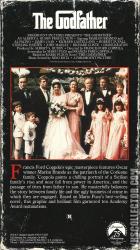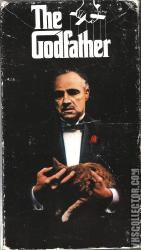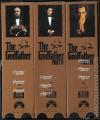The Godfather
Catalog Number
8049
-
Primary Distributor (If not listed, select "OTHER")
Catalog Number
8049
Primary Distributor (If not listed, select "OTHER")
Release Year
Country
175 mins (NTSC)
N/A | N/A | N/A
N/A | N/A
The Godfather (1972)
Additional Information
Additional Information
An offer you can't refuse.
Popularly viewed as one of the best American films ever made, the multi-generational crime saga The Godfather is a touchstone of cinema: one of the most widely imitated, quoted, and lampooned movies of all time. Marlon Brando and Al Pacino star as Vito Corleone and his youngest son, Michael, respectively. It is the late 1940s in New York and Corleone is, in the parlance of organized crime, a "godfather" or "don," the head of a Mafia family. Michael, a free thinker who defied his father by enlisting in the Marines to fight in World War II, has returned a captain and a war hero. Having long ago rejected the family business, Michael shows up at the wedding of his sister, Connie (Talia Shire), with his non-Italian girlfriend, Kay (Diane Keaton), who learns for the first time about the family "business." A few months later at Christmas time, the don barely survives being shot by gunmen in the employ of a drug-trafficking rival whose request for aid from the Corleones' political connections was rejected. After saving his father from a second assassination attempt, Michael persuades his hotheaded eldest brother, Sonny (James Caan), and family advisors Tom Hagen (Robert Duvall) and Sal Tessio (Abe Vigoda) that he should be the one to exact revenge on the men responsible. After murdering a corrupt police captain and the drug trafficker, Michael hides out in Sicily while a gang war erupts at home. Falling in love with a local girl, Michael marries her, but she is later slain by Corleone enemies in an attempt on Michael's life. Sonny is also butchered, having been betrayed by Connie's husband. As Michael returns home and convinces Kay to marry him, his father recovers and makes peace with his rivals, realizing that another powerful don was pulling the strings behind the narcotics endeavor that began the gang warfare. Once Michael has been groomed as the new don, he leads the family to a new era of prosperity, then launches a campaign of murderous revenge against those who once tried to wipe out the Corleones, consolidating his family's power and completing his own moral downfall. Nominated for 11 Academy Awards and winning for Best Picture, Best Actor (Marlon Brando), and Best Adapted Screenplay, The Godfather was followed by a pair of sequels.
e Godfather is a 1972 American crime film directed by Francis Ford Coppola and produced by Albert S. Ruddy from a screenplay by Mario Puzo and Coppola. Based on Puzo's 1969 novel of the same name, the film stars Marlon Brando and Al Pacino as the leaders of a powerful New York crime family. The story, spanning the years 1945 to 1955, centers on the transformation of Michael Corleone (Pacino) from reluctant family outsider to ruthless Mafia boss while also chronicling the Corleone family under the patriarch Vito Corleone (Brando).
The Godfather is widely regarded as one of the greatest films in world cinema[3]—and as one of the most influential, especially in the gangster genre.[4] Now ranked as the second greatest film in American cinema (behind Citizen Kane) by the American Film Institute,[5] it was selected for preservation in the United States National Film Registry in 1990.[6]
The film was for a time the highest grossing picture ever made, and remains the box office leader for 1972. It won three Oscars that year: for Best Picture, for Best Actor (Brando) and in the category Best Adapted Screenplay for Puzo and Coppola. Its nominations in seven other categories included Pacino, James Caan and Robert Duvall for Best Supporting Actor and Coppola for Best Director. The success spawned two sequels: The Godfather Part II in 1974, and The Godfather Part III in 1990.
100) based on 14 reviews from mainstream critics, considered to be "universal acclaim".[38]
Both The Godfather and The Godfather Part II were selected for preservation in the United States National Film Registry in 1990 and 1993, respectively. International critics routinely list these two among cinema's pinnacle achievements, sometimes considering them as one work. In the decennial 2002 Sight & Sound poll of film directors, the pair was ranked as the second best film of all time.[40] The critics poll separately voted it fourth. The American Film Institute[5] has listed it second in U.S. film history behind Citizen Kane. Other polls and publications have it first, as well, among them Entertainment Weekly,[41] and Empire magazine (November 2008)[42]
Love Theme From The Godfather
MENU0:00
by Nino Rota (music) and Larry Kusic(lyrics)
Problems playing this file? See media help.
The soundtrack's main theme by Nino Rota was also critically acclaimed; the main theme ("Speak Softly Love") is well-known and widely used (see Score Controversy for more information).
Director Stanley Kubrick believed that The Godfather was possibly the greatest movie ever made, and had without question the best cast.[43]
Previous Mafia movies had looked at the gangs from the perspective of an outraged outsider.[44] In contrast, The Godfather presents the gangster's perspective of the Mafia as a response to corrupt society.[44] Although the Corleone family is presented as immensely rich and powerful, no scenes depict prostitution, gambling, loan sharking or other forms of racketeering.[45] Some critics argue that the setting of a criminal counterculture allows for unapologetic gender stereotyping, and is an important part of the film's appeal ("You can act like a man!", Don Vito tells a weepy Johnny Fontane).[46]
Real-life gangsters responded enthusiastically to the film, with many of them feeling it was a portrayal of how they were supposed to act.[47] Salvatore "Sammy the Bull" Gravano, the former Underboss in the Gambino crime family,[48] stated: "I left the movie stunned ... I mean I floated out of the theater. Maybe it was fiction, but for me, then, that was our life. It was incredible. I remember talking to a multitude of guys, made guys, who felt exactly the same way. " According to Anthony Fiato after seeing the film, Patriarca crime family members Paulie Intiso and Nicky Giso altered their speech patterns closer to that of Vito Corleone's.[49] Intiso would frequently swear and use poor grammar; but after the movie came out, he started to articulate and philosophize more.[49]
Remarking on the 40th anniversary of the film's release, film critic John Podhoretz praised The Godfather as "arguably the great American work of popular art" and "the summa of all great moviemaking before it".[50] Two years before, Roger Ebert wrote in his journal that it "comes closest to being a film everyone agrees... is unquestionably great."
The theatrical version of The Godfather debuted on network television in 1974 with only minor edits. The next year, Coppola created The Godfather Saga expressly for American television in a release that combined The Godfather and The Godfather Part II with unused footage from those two films in a chronological telling that toned down the violent, sexual, and profane material for its NBC debut on November 18, 1977. In 1981, Paramount released the Godfather Epic boxed set, which also told the story of the first two films in chronological order, again with additional scenes, but not redacted for broadcast sensibilities. Coppola returned to the film again in 1992 when he updated that release with footage from The Godfather Part III and more unreleased material. This home viewing release, under the title The Godfather Trilogy 1901–1980, had a total run time of 583 minutes (9 hours, 43 minutes), not including the set's bonus documentary by Jeff Werner on the making of the films, "The Godfather Family: A Look Inside".
The Godfather DVD Collection was released on October 9, 2001 in a package[66] that contained all three films—each with a commentary track by Coppola—and a bonus disc that featured a 73-minute documentary from 1991 entitled The Godfather Family: A Look Inside and other miscellany about the film: the additional scenes originally contained in The Godfather Saga; Francis Coppola's Notebook (a look inside a notebook the director kept with him at all times during the production of the film); rehearsal footage; a promotional featurette from 1971; and video segments on Gordon Willis's cinematography, Nino Rota's and Carmine Coppola's music, the director, the locations and Mario Puzo's screenplays. The DVD also held a Corleone family tree, a "Godfather" timeline, and footage of the Academy Award acceptance speeches.
Release Date: March 24, 1972
Distrib: Paramount
Boxoffice: $133,698,921 2013: $624,452,600
Popularly viewed as one of the best American films ever made, the multi-generational crime saga The Godfather is a touchstone of cinema: one of the most widely imitated, quoted, and lampooned movies of all time. Marlon Brando and Al Pacino star as Vito Corleone and his youngest son, Michael, respectively. It is the late 1940s in New York and Corleone is, in the parlance of organized crime, a "godfather" or "don," the head of a Mafia family. Michael, a free thinker who defied his father by enlisting in the Marines to fight in World War II, has returned a captain and a war hero. Having long ago rejected the family business, Michael shows up at the wedding of his sister, Connie (Talia Shire), with his non-Italian girlfriend, Kay (Diane Keaton), who learns for the first time about the family "business." A few months later at Christmas time, the don barely survives being shot by gunmen in the employ of a drug-trafficking rival whose request for aid from the Corleones' political connections was rejected. After saving his father from a second assassination attempt, Michael persuades his hotheaded eldest brother, Sonny (James Caan), and family advisors Tom Hagen (Robert Duvall) and Sal Tessio (Abe Vigoda) that he should be the one to exact revenge on the men responsible. After murdering a corrupt police captain and the drug trafficker, Michael hides out in Sicily while a gang war erupts at home. Falling in love with a local girl, Michael marries her, but she is later slain by Corleone enemies in an attempt on Michael's life. Sonny is also butchered, having been betrayed by Connie's husband. As Michael returns home and convinces Kay to marry him, his father recovers and makes peace with his rivals, realizing that another powerful don was pulling the strings behind the narcotics endeavor that began the gang warfare. Once Michael has been groomed as the new don, he leads the family to a new era of prosperity, then launches a campaign of murderous revenge against those who once tried to wipe out the Corleones, consolidating his family's power and completing his own moral downfall. Nominated for 11 Academy Awards and winning for Best Picture, Best Actor (Marlon Brando), and Best Adapted Screenplay, The Godfather was followed by a pair of sequels.
e Godfather is a 1972 American crime film directed by Francis Ford Coppola and produced by Albert S. Ruddy from a screenplay by Mario Puzo and Coppola. Based on Puzo's 1969 novel of the same name, the film stars Marlon Brando and Al Pacino as the leaders of a powerful New York crime family. The story, spanning the years 1945 to 1955, centers on the transformation of Michael Corleone (Pacino) from reluctant family outsider to ruthless Mafia boss while also chronicling the Corleone family under the patriarch Vito Corleone (Brando).
The Godfather is widely regarded as one of the greatest films in world cinema[3]—and as one of the most influential, especially in the gangster genre.[4] Now ranked as the second greatest film in American cinema (behind Citizen Kane) by the American Film Institute,[5] it was selected for preservation in the United States National Film Registry in 1990.[6]
The film was for a time the highest grossing picture ever made, and remains the box office leader for 1972. It won three Oscars that year: for Best Picture, for Best Actor (Brando) and in the category Best Adapted Screenplay for Puzo and Coppola. Its nominations in seven other categories included Pacino, James Caan and Robert Duvall for Best Supporting Actor and Coppola for Best Director. The success spawned two sequels: The Godfather Part II in 1974, and The Godfather Part III in 1990.
100) based on 14 reviews from mainstream critics, considered to be "universal acclaim".[38]
Both The Godfather and The Godfather Part II were selected for preservation in the United States National Film Registry in 1990 and 1993, respectively. International critics routinely list these two among cinema's pinnacle achievements, sometimes considering them as one work. In the decennial 2002 Sight & Sound poll of film directors, the pair was ranked as the second best film of all time.[40] The critics poll separately voted it fourth. The American Film Institute[5] has listed it second in U.S. film history behind Citizen Kane. Other polls and publications have it first, as well, among them Entertainment Weekly,[41] and Empire magazine (November 2008)[42]
Love Theme From The Godfather
MENU0:00
by Nino Rota (music) and Larry Kusic(lyrics)
Problems playing this file? See media help.
The soundtrack's main theme by Nino Rota was also critically acclaimed; the main theme ("Speak Softly Love") is well-known and widely used (see Score Controversy for more information).
Director Stanley Kubrick believed that The Godfather was possibly the greatest movie ever made, and had without question the best cast.[43]
Previous Mafia movies had looked at the gangs from the perspective of an outraged outsider.[44] In contrast, The Godfather presents the gangster's perspective of the Mafia as a response to corrupt society.[44] Although the Corleone family is presented as immensely rich and powerful, no scenes depict prostitution, gambling, loan sharking or other forms of racketeering.[45] Some critics argue that the setting of a criminal counterculture allows for unapologetic gender stereotyping, and is an important part of the film's appeal ("You can act like a man!", Don Vito tells a weepy Johnny Fontane).[46]
Real-life gangsters responded enthusiastically to the film, with many of them feeling it was a portrayal of how they were supposed to act.[47] Salvatore "Sammy the Bull" Gravano, the former Underboss in the Gambino crime family,[48] stated: "I left the movie stunned ... I mean I floated out of the theater. Maybe it was fiction, but for me, then, that was our life. It was incredible. I remember talking to a multitude of guys, made guys, who felt exactly the same way. " According to Anthony Fiato after seeing the film, Patriarca crime family members Paulie Intiso and Nicky Giso altered their speech patterns closer to that of Vito Corleone's.[49] Intiso would frequently swear and use poor grammar; but after the movie came out, he started to articulate and philosophize more.[49]
Remarking on the 40th anniversary of the film's release, film critic John Podhoretz praised The Godfather as "arguably the great American work of popular art" and "the summa of all great moviemaking before it".[50] Two years before, Roger Ebert wrote in his journal that it "comes closest to being a film everyone agrees... is unquestionably great."
The theatrical version of The Godfather debuted on network television in 1974 with only minor edits. The next year, Coppola created The Godfather Saga expressly for American television in a release that combined The Godfather and The Godfather Part II with unused footage from those two films in a chronological telling that toned down the violent, sexual, and profane material for its NBC debut on November 18, 1977. In 1981, Paramount released the Godfather Epic boxed set, which also told the story of the first two films in chronological order, again with additional scenes, but not redacted for broadcast sensibilities. Coppola returned to the film again in 1992 when he updated that release with footage from The Godfather Part III and more unreleased material. This home viewing release, under the title The Godfather Trilogy 1901–1980, had a total run time of 583 minutes (9 hours, 43 minutes), not including the set's bonus documentary by Jeff Werner on the making of the films, "The Godfather Family: A Look Inside".
The Godfather DVD Collection was released on October 9, 2001 in a package[66] that contained all three films—each with a commentary track by Coppola—and a bonus disc that featured a 73-minute documentary from 1991 entitled The Godfather Family: A Look Inside and other miscellany about the film: the additional scenes originally contained in The Godfather Saga; Francis Coppola's Notebook (a look inside a notebook the director kept with him at all times during the production of the film); rehearsal footage; a promotional featurette from 1971; and video segments on Gordon Willis's cinematography, Nino Rota's and Carmine Coppola's music, the director, the locations and Mario Puzo's screenplays. The DVD also held a Corleone family tree, a "Godfather" timeline, and footage of the Academy Award acceptance speeches.
Release Date: March 24, 1972
Distrib: Paramount
Boxoffice: $133,698,921 2013: $624,452,600
Related Links
Related Releases3
Catalog Number
8049
Primary Distributor (If not listed, select "OTHER")
The Godfather (1972)
Release Year
Catalog Number
8049
Primary Distributor (If not listed, select "OTHER")
Catalog Number
8049
Catalog Number
15146
Primary Distributor (If not listed, select "OTHER")
The Godfather (1972)
The Godfather: Part II
Release Year
Catalog Number
15146
Primary Distributor (If not listed, select "OTHER")
Catalog Number
15146
Catalog Number
080491
Primary Distributor (If not listed, select "OTHER")
The Godfather (1972)
Release Year
Catalog Number
080491
Primary Distributor (If not listed, select "OTHER")
Catalog Number
080491
















Comments0
Login / Register to post comments